As usual, a caseSTUDY begins with customers. However, this one started unusually enough in that it was *us* noticing a buying pattern of just two servos, either DS100DLHV or DS150CLHV. Curious what this was about because the days of 2-channel .049 models has long gone by, I reached out to a few fellows and learned they were upgrading their Freewing Mig.29 elevator servos. Or as some call them, tailerons because they're full flying stabs. So if your transmitter supports the function, you can mix aileron and elevator servos and make this thing roll quick as an alligator in a death roll.
Along the way, as usually happens, word got around we had a neat solution to a problem of these things sometimes doing a terminal lawn dart nose dive. Suddenly, lots of folks were calling and asking question. And these quickly established a pattern for three types of calls.
First, folks who had replaced their $600 model and didn't want to have it happen again. They proactively were getting ahead of the issue and wanted advice on whether to get our DS100 or DS150. Second, those who hadn't yet lost theirs, and wanted to keep it that way. And third, folks who said bag it, this thing is so sweet I want to replace them all!
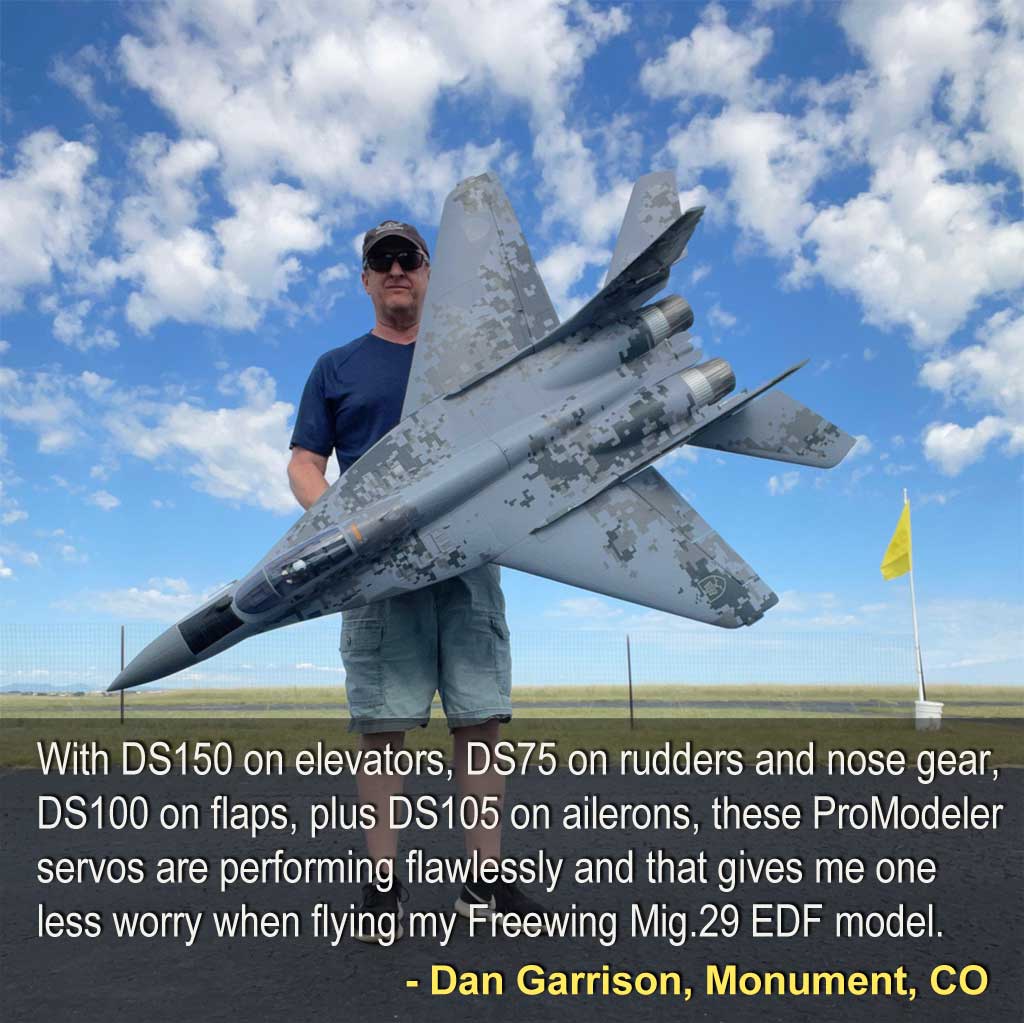

And the common theme, as you might expect, being one of irritation at forking over 600 bucks only to realize some of the components within the product aren't up to their standards. Fair enough; I'm not here to defend Freewing *but* I will observe that if you take into account everything you get in the box . . . it's one Hell of a deal. How can I make this judgement?
Simple, after watching videos by a fellow who subsequently became my customer and friend, Jandro in Spain, I bought one for myself! And there's nothing like having my own shekels on the line to give me leave to observe once again, this thing is one Hell of a deal (and Freewing won't even buy me a milkshake for expressing my opinion). Saying I have no dog in the hunt.
Put another way, this model is magnificent and if they charged the same for it *without* the dinky servos, I'd still pony up the dough and wouldn't grouse, but I'll do me and you do you. Point being, it's my opinion that if you feel the model needs upgraded servos, then do it and quit your bellyaching because this thing is nice enough to deserve it! And this would be true whether we were in the servo business, or not, added to which, I replace servos in many, many foamies. So what's the beef?
Now let's dive into the meat of the guide and let me share a few thoughts regarding what 'I' and a few others think you can do to customize your model so that a) yours doesn't lawn dart on you, and b) bring it up to snuff so it meets your standard, aka making a good thing better!

This, information came about after reviewing a 'lot' of information online (forum threads/pages, blogs, Facebook, etc.), along with videos showing what's happening as the model enters a terminal dive into the deck, plus studying loads of photos, added to a generous helping of time by selfless folks on the phone trying to help me grasp what's going on (thanks John, Andrew, Greg, Steve, Dave, Evan, et al), then I believe it's actually pretty easy to make this model into something better through the application of common sense upgrades that won't break the bank.
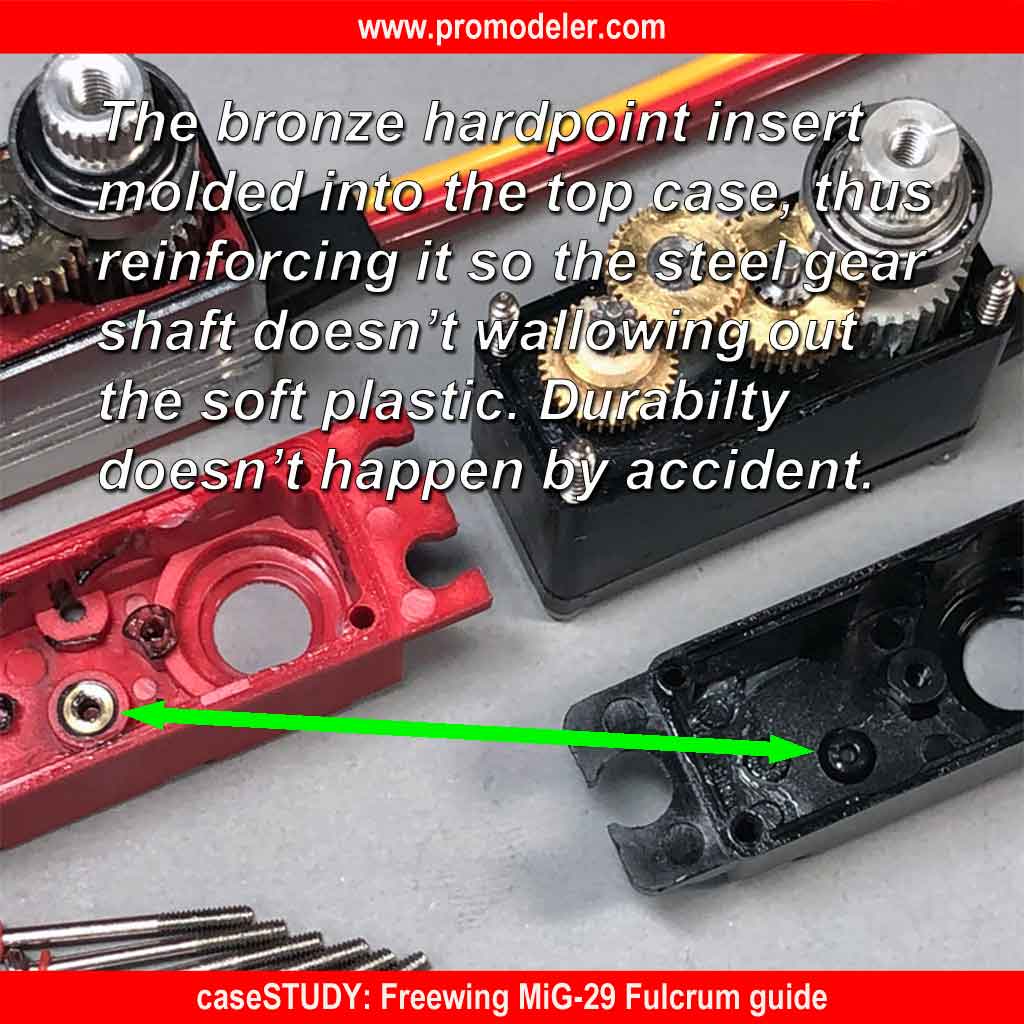

Disclaimer:
Three things. First, allow me to observe this; Freewing is - in my opinion - to be congratulated for offering such a terrific value. Honestly, for about $600, they deliver a phenomenal product. It's one, which once upon a time involved forking over maybe $10,000 to the likes of Bob Violet Models to experience.
Freewing offers something, which is little short of a manufacturing miracle! Best of all, they do it without your expending much effort toward building, painting, installing retracts, servos, making linkages, figuring out lights, sequencing gear doors, fan units, ESC, BEC, etc. (plus spending oodles of money). Appreciate it for what it is because nothing's perfect!
Second, and quite honestly, for the 600 bucks involved, I think you'd have to be a special kind of stupid not to realize compromises are being made in an attempt to hit a price point. Since nobody flying complex models like this is stupid, then as long as you also recognize only God is perfect (and everybody else is doing their best), then we can try to apply proven modeling techniques to help bring the product up to your standards.
Third, and my larger point; I'm not here to point fingers, or cast blame. Bottom line? I'd like to try and offer a solution. Nothing more.
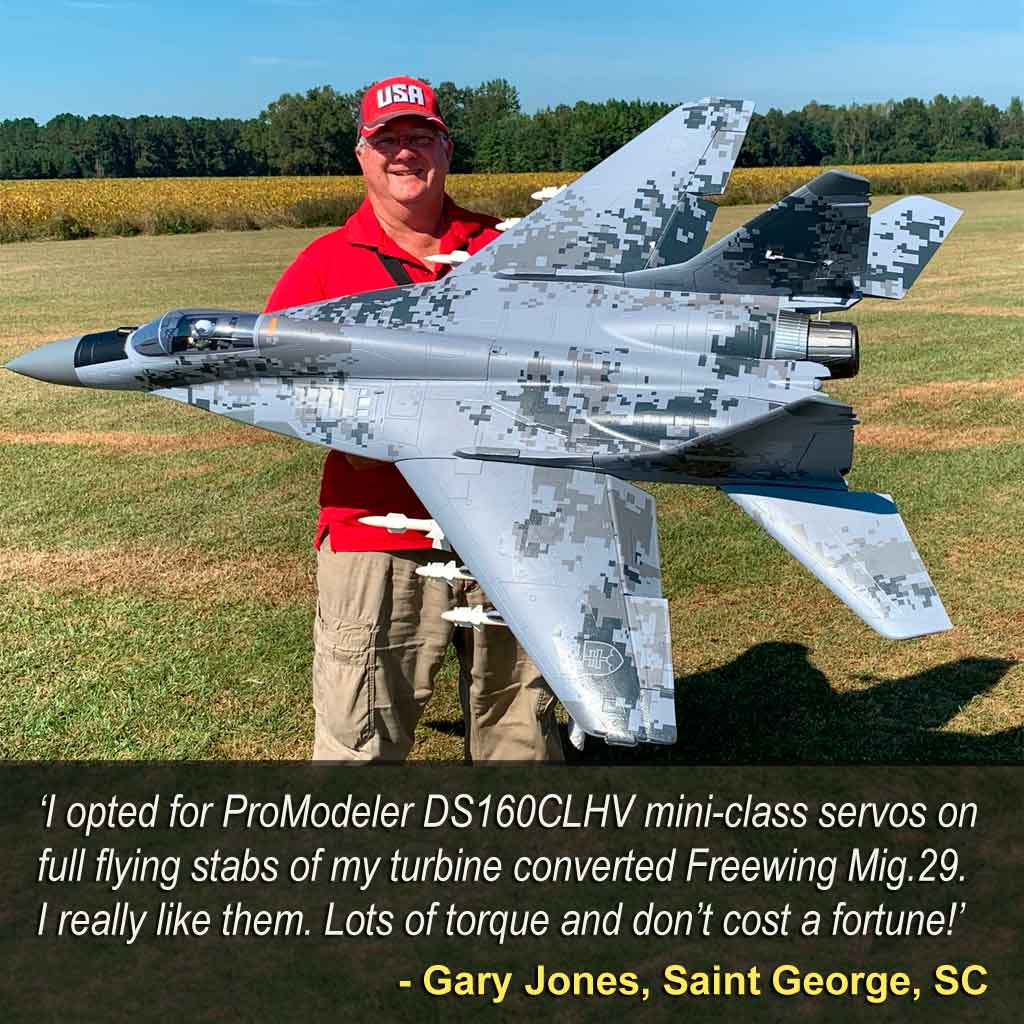

Note 1: what I have to say in part applies to using my brand of micro and sub-micro servos. But nothing says you can't use another good quality servo from the likes of my competitors, e.g. Savox, MKS, Hitec, etc. As such, because it would take a saint to not talk up my product (and I'm a sinner like everybody else), it's going to be on 'you' to decide what's in your own self-interests servo-wise. Put another way, ProModeler servos speak for themselves. This article is principally designed to help solve a problem before someone gets hurt!
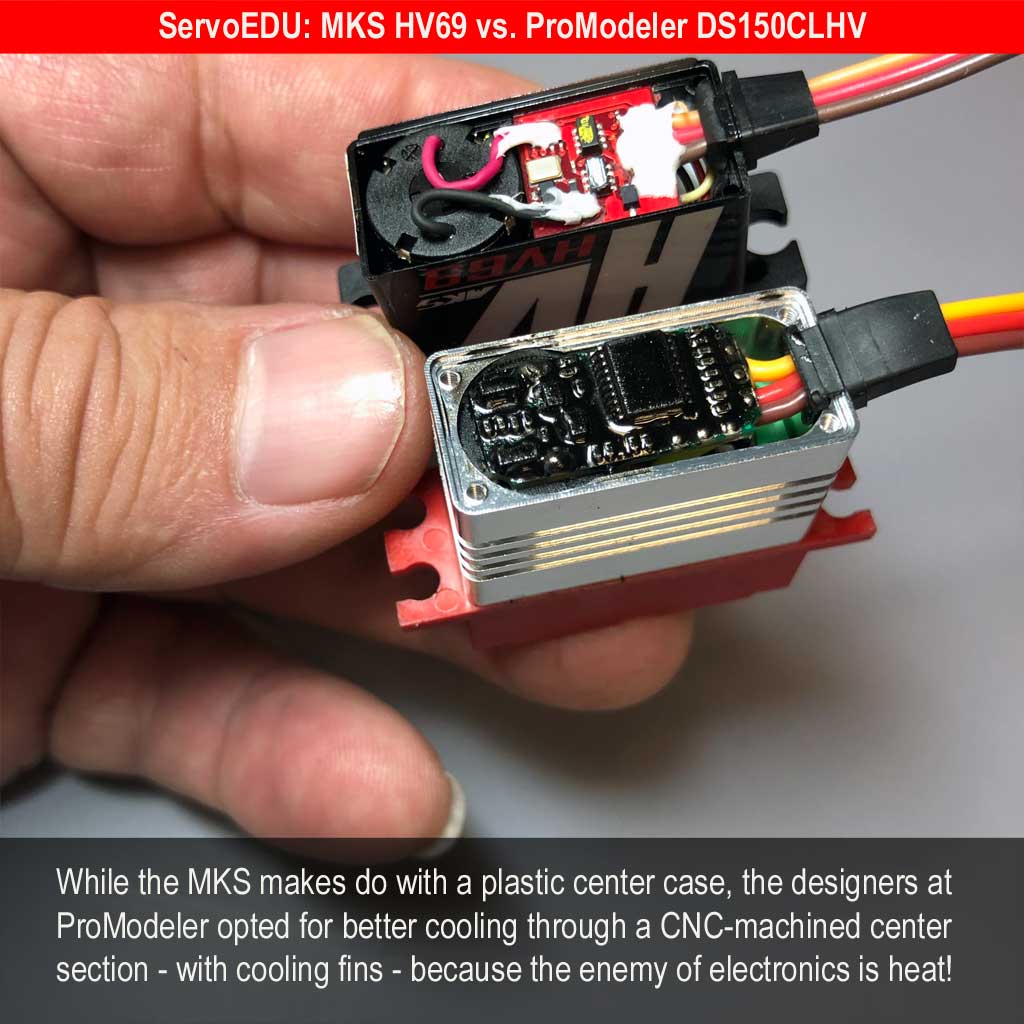

Preview:
So let's proceed and before I do, I'll tell you in advance who killed Cock Robin . . . and then we'll get into the whys and wherefores. My basic advice is you should operate a split voltage system, improve some components, and especially upgrade the power supply. This means more than better servos, and includes paying attention to details like the control linkages, heavier servo extensions, and especially, upgrading or eliminating the BEC for the avionics. Why? It's because no one thing solves all the issues . . . we're dealing with a system!
Recapping the issues;
The model is supplied with two basic servos, the Freewing 9g and Freewing 17g (and yes, I'm aware in an ethical attempt to help, Motion RC sent out for free similar-size 23g servos to replace the original 17g servos). By the way, we refer to a 9g servo as a sub-micro size, and their 17/23g servo as micro-size (as opposed to significantly larger standard and mini-size servos).
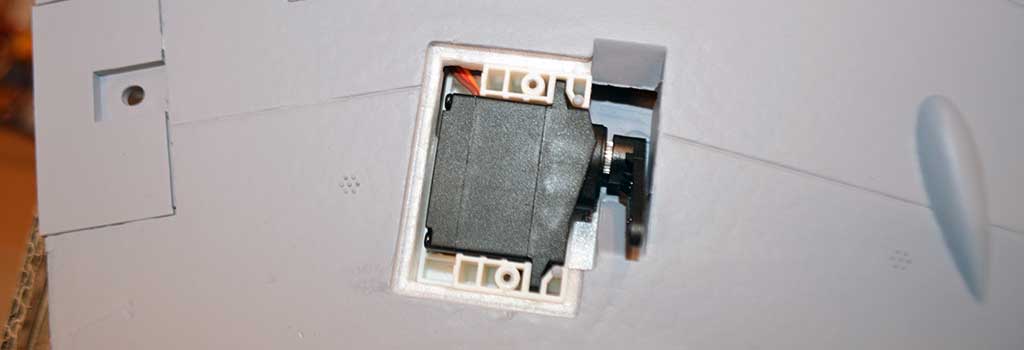
- 17/23g nestled within a pre-molded pocket . . . the model is superbly engineered

Anyway, power for the servos is supplied via an 8A BEC connected to a propulsion battery, the juice travels through servo extensions to the servos, where they act on the flight controls through pushrods. These are the principal components involved in how you're going to customize your Mig-29. So if you'd like to learn more, review this: BEC or dedicated pack?
And note, as usual, clicking the link opens the article in it's own browser tab so you won't lose your place here.
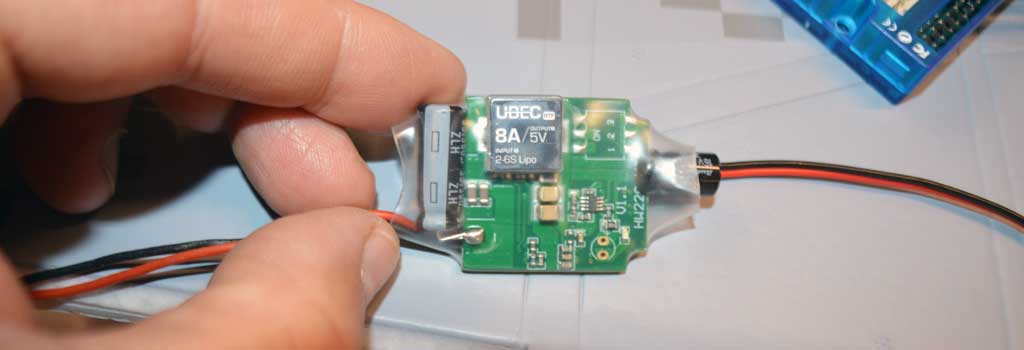
- Is 8A enough for 11 servos, retracts, and lights? Maybe, but more is better!

Beyond recommending better servos for the flight controls (stronger and faster, e.g. the same thing Motion says when they send 23g to replace 17g), it's my opinion you also need to upgrade both their power source (the BEC that provides juice to the magic blue box for controlling 11 servos, retracts, and lights), along with the servo extensions (heavier gauge wire reduces voltage losses), and of course, stiffening up the pushrods won't go amiss.

Pros and cons:
This last, pushrods, are an especially important detail because improved servos means harnessing more powerful servos and transmitting more force. In short, stiffer/stronger pushrods are good!
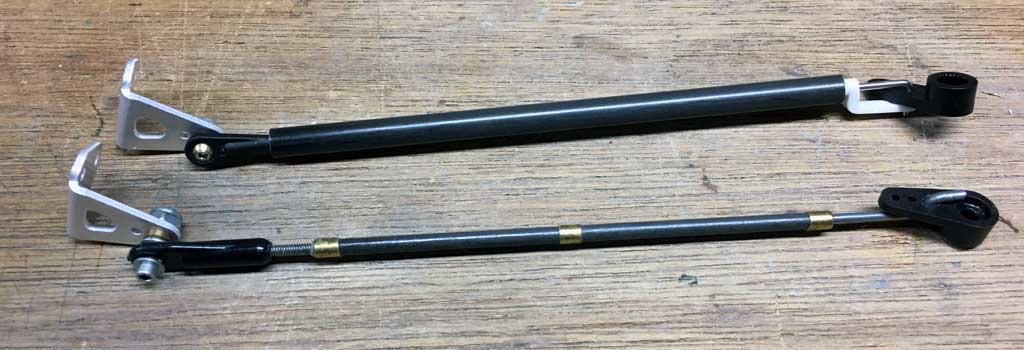
- A highly experienced modeler sleeved this pushrod - note brass tubing

Anyway, while our servos will operate on 5V (whilst delivering significantly more power than the stock servos), we can't repeal the laws of physics. The meaning is they will not deliver the torque or the speed of which they're capable on higher voltage. So operating them on SV is akin to sending out our Olympic sprinter to race with a sack of corn on his back, he's been handicapped! Do they nevertheless produce enough torque to fly the model on 5V? Yeah, but you're at the deep end of the pool with this model so my advice is assess the possibilities and plan accordingly.

BEC:
So first let's look at the power source, the OEM BEC (OEM means original equipment manufacturer, e.g the one they supply, and BEC means battery eliminator circuit). Things get interesting here because it's my opinion the supplied BEC is marginal. Don't shoot the messenger, please, this is my opinion, but it's based on long experience. Moreover, it's a 5V unit because the OEM servos, the blue control box, and everything involved in the control avionics revolves around standard voltage. Add to it, if you go over 5V you risk releasing the magic smoke contained within the blue box. Ditto the servos themselves (while the LEDs probably don't care). Anyway, this is bad juju!
If you want to learn more, this article titled: Bypassing the BEC and other power subjects, may prove to be useful reading.
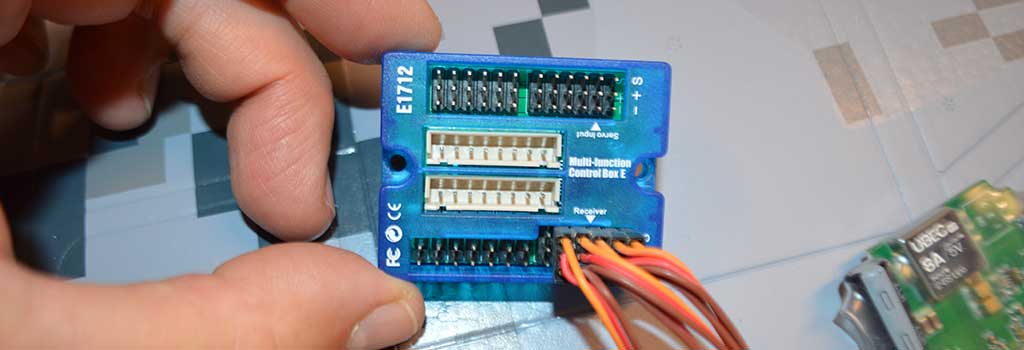
- This nifty device synchronizes retracts, gear doors, and more!

Q. What about replacing the stock BEC and using an aftermarket BEC
A. This is a good idea - and we offer the Castle Creations CC BEC 2.0 - but no matter what it's only part of the plan in my opinion. Also, and take note of this; while on 6S it's rated at 13A (at 5VDC) or 5A more than the OEM unit, but there's a but involved.
The fly in the ointment is this BEC (like the OEM unit) is drawing down one of the model's two propulsion-packs, thus unbalancing the system. Do you like this idea? I'm not wild about it, myself. So maybe consider tapping into both packs and using diodes to keep from having a problem. They cost you 0.5V but are worth it for safety.
And yes, you can use the same BEC on 12S, but (there it is again) if you read the specs (you do read specs, right?), then you'll learn that on a 12S source the CC BEC 2.0 is actually only rated at 8A, which is the same as the OEM unit. Thus, it's 'my' opinion, if the OEM BEC isn't enough then this one isn't either - not for 11 servos, retracts, and lights. More later.
Add to it, please take note there's an asterisk by the CC BEC 2.0 specs related to temperature, which you would do well to read if you fly at more than 77°F (25°C) ambient . . . so consider yourself warned regarding the ratings, OK?
Finally while you're shopping around, consider this too; Patrick produces these domestically, they're considered the best in the world, and going against the supplied unit, a no-name import whose specifications we don't know squat about, and is likely supplied by low bidder?!? My point is this; please think this through with a large grain of salt!
Also, and more importantly, none of this addresses the fact the stock 5V OEM servos aren't exactly the stuff legends are made of, and more powerful servos will require even more current, do you catch my drift? So what do you do, instead?

HV and SV:
I suggest a split-voltage solution. Basically, replace the servos with HV units and run them at high voltage and at the same time let the OEM BEC continue to supply 5V of power to the blue box (for controlling retracts, sequence gear doors, and make the lights do their thing). Anyway, because HV will fry the OEM servos this solution will involve spending some more money . . . but what's the price of your model going splat on the runway, or heaven forbid, doing so within the pits? Food for thought, eh?
So my idea revolves around using HV for the servos (HV being defined as 7.4-8.4VDC), and continuing to use the OEM SV system (SV means standard voltage, e.g. 4.8-6.0VDC). Splitting the voltage means higher servo performance whilst keeping the blue box for all the nifty stuff it does. Nice!
Why? Well, it's complicated but it's my opinion the chain of events leading to the crashes is composed of several factors. One being the compromises due to OEM-servo selection. Another being compromises made in pushrod construction (fine with stock servos but worth a look if fitted with more powerful servos). Also, the aforementioned compromises in the BEC powering the whole shooting match. Plus there may be further compromises made with respect to various wire gauges of the many extensions (possibly resulting in significant voltage loses at the servos). I'm speaking of this in terms of them not having enough oomph (highly technical word for balls) to competently control the flight path of a relatively heavy model. Especially one moving at a fairly significant airspeed. Yup, Freewing's fine engineers are juggling a lot of balls in the air, wouldn't you agree?
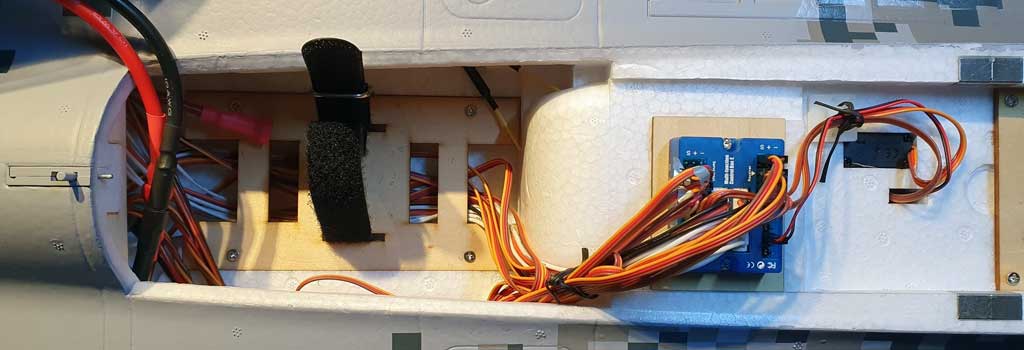
- Can you say rat's nest? You betcha there is some voltage loss involved!

The point being, there's no such thing as a perfect world, and there's no such thing as a free lunch. Could they (Freewing) offer a better package? Sure, but are you prepared to pony up maybe $1000-1500 instead of $600? I didn't think so. Anyway, a real solution will likely involve addressing as many of these issues as is required for 'you' to feel comfortable before throttling up the model and going around the patch.
Let me relate a further bit of information in my highlighting the use of the word 'you'. In addition to flying model airplanes, I fly a Bonanza - yes, 1:1 scale. Not bragging but merely observing how it's on me to perform a pre-flight, it's also on me to evaluate 'my' condition before taking the controls, plus it's on me to account for the weather conditions before departing (plus enroute and destination weather), plus it's on me to determine whether the weight and balance of the aircraft are safe, etc.
In short, it's on me. It's not on air traffic control, it's not on you, and it's certainly not on Beechcraft. Flying, whether it's full scale or a model, involves risk and accepting the same level of personal responsibility - it's always on the pilot - you! Fact.
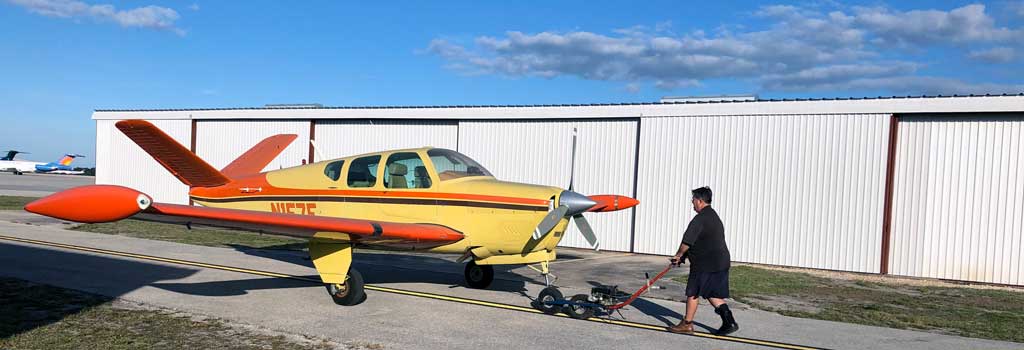

Thus, merely replacing the servos with more powerful units will (again in my opinion) leave you at the mercy of the BEC-limits. Ignoring the gauge of the servo-extension wire leaves you looking at perhaps significant voltage loss at the servo. Ignoring opportunities for improving the pushrods means risking deflection, which could result in loss of control. Shall I go on? Anyway, splitting the voltage helps solve some of these issues with reasonable economy. Basic modeling techniques will help address others. Let's delve in!

Existing servos at 5VDC nominal:
- Freewing 9g - 23.5x12.2x26.4mm - 22.21oz/in, 0.12se/60°
- Freewing 17g - 28.5x13.5x30mm - 34.71oz/in, 0.14se/60°
- Freewing 23g - 28.5x13.5x30mm - 42.22oz/in, undisclosed
Note 2: Motion RC info regarding 23g servo upgrading the 17g servo;
https://www.motionrc.com/pages...
Notable issues to overcome:
- Feeding more than 5V risks frying the blue control box.
- Servo-torque - especially considering it's a fast heavy mover.
- Adequate current delivery (basically, the stock BEC).
- Servo-extension gauge resulting in higher voltage losses.
- Improve control pushrod linkages.
Background:
The evolution of high voltage servos is due in part to a desire to improve performance. Basically, the higher the voltage the higher the torque and at the same time, the faster the servo responds (until a limit is reached at which point in time it goes poof and emits the magic smoke).
Can an SV servo be made equally as powerful and fast as one that operates at HV? Yes, but as always, there's a compromise. In this case it would dictate heavier components and weight's an anathema to things that fly. Basically, it's easier (read more economical) to increase servo performance via higher voltage. How much voltage is enough? Right now the market has determined we're 'there' with between 7.4-8.4VDC. Convenient, too, because there's also been a sea change from the traditional 4-5 cell NiCd packs (4.8-60VDC) vs. 2S LiPo packs (7.4VDC nominal), and BEC circuits (8.4VDC - but more later).

Solutions:
1. Due to the integration of the blue control box, and the limitations of the OEM BEC (battery eliminator circuit) unit, it's my opinion the best solution is to split the voltages. Basically, run a 2S LiPo for the flight control servos and continue to rely on the stock BEC for powering everything else, e.g. all the non-mission critical stuff like lights, retracts, etc. Easy peasy and best of all? This actually costs very little! Why a 2S LiPo? Because it's cheap, delivers the right voltage for HV servos, and outputs 20-30A of current, which is plenty!
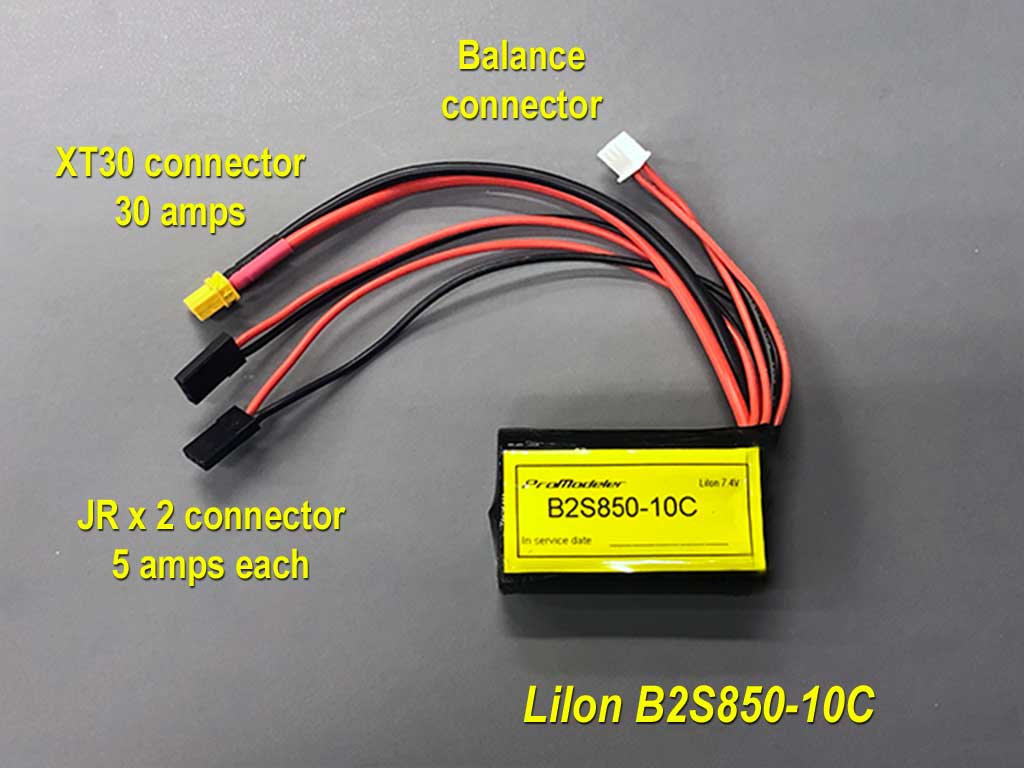
- Inexpensive B2S850 offers enough current and three ways to connect it

2. It's my experience a model weighing in at 12-15 pounds and flying at 80mph, give or take, will be more satisfactory for the pilot if equipped with more powerful and faster servos than the OEM units. Anyway, these are my specific thoughts regarding servos based on what we offer.
- Replace the 23g flying stab servos with ProModelerDS150CLHV servos.
- Replacing 17g flaps servos with the same ProModeler DS150CLHV servos.
- Replace 17g ailerons servos with ProModeler DS100DLHV servos (if budget dictates).
- Replace 9g rudder servos with ProModeler DS75CLHV servos - or - DS105CLHV servos.
- Ditto the DS75CLHV servos for nose wheel steering and gear-doors.

Note 3: both DS110DLHV and DS150CLHV dimensions are 29x13.5x30mm, which compares quite closely to the OEM 17/23g servos at 28.5x13.5x30mm. They're a tiny bit longer, and probably within the nominal dimensions of the mount. Nevertheless, we're only talking about 1/4 the thickness of a dime longer (a dime is about 2mm thick). The point being, perhaps a very small bit of trimming required, but maybe not, and thus, if modifications are required to fit these, they are minimal.
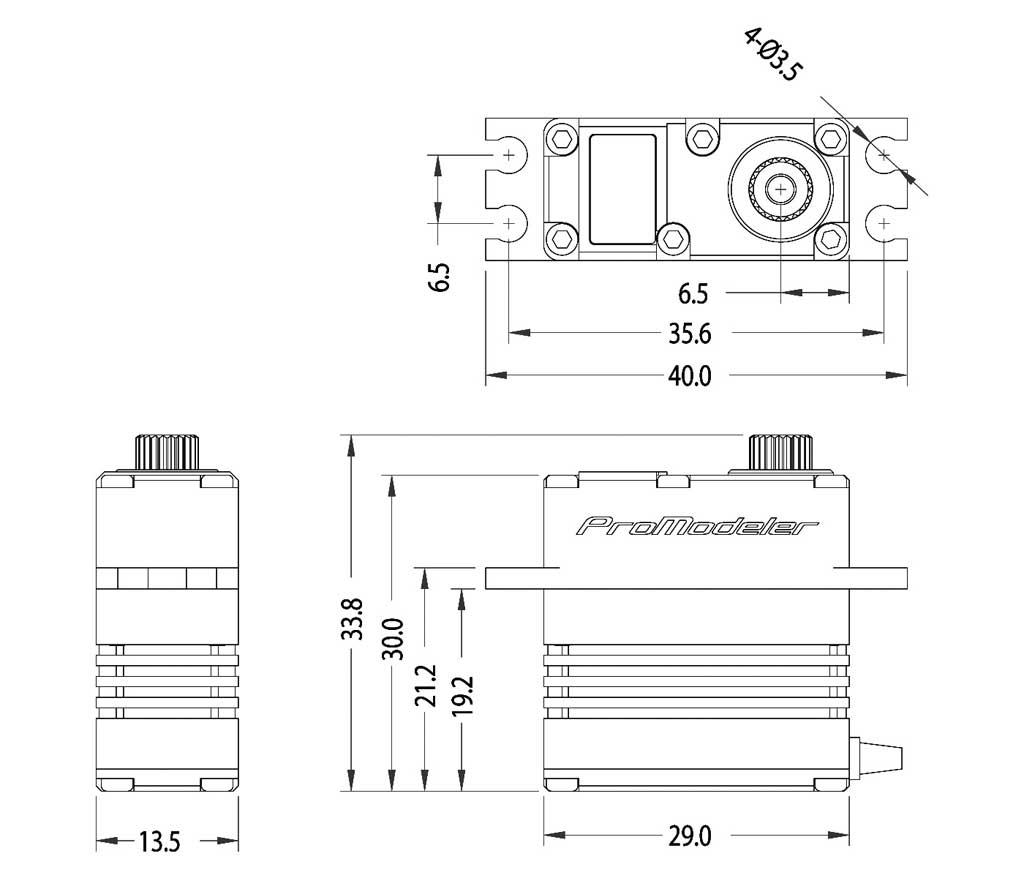

Similarly, both DS75CLHV and DS105CLHV sub-micro servo dimensions of 22.6x12.6x27.5mm compare well to the 9g Freewing at 23.5x12.2x26.4mm.
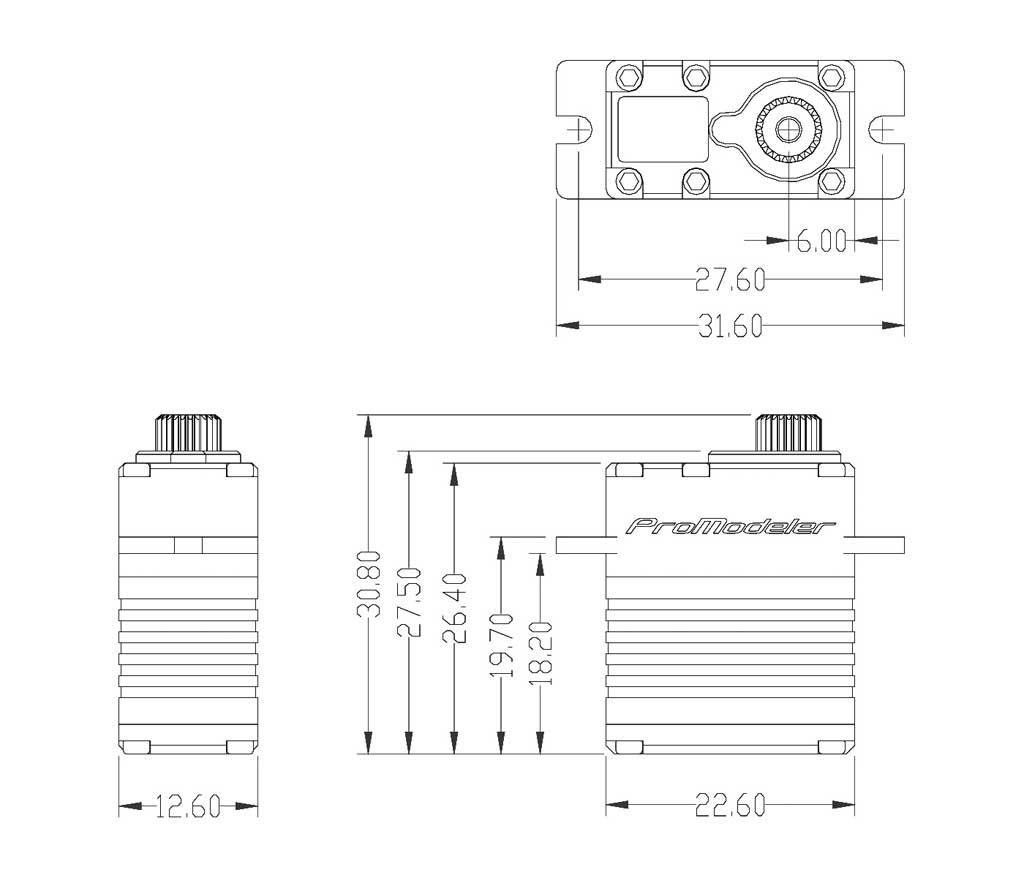

Performance-wise, ProModeler compares more than favorably to Freewing. Remember, the 9g compares size-wise to the DS75/DS105 and the 17/23g compares to the DS100/DS150 . . . and at 5VDC nominal:
- DS75CLHV - 45oz-in - 0.147sec/60°
- DS105CLHV - 63oz-in - 0.191sec/60°
- DS100DLHV - 70oz-in - 0.209sec/60°
- DS150CLHV - 115oz-in - 0.162sec/60°
- Freewing 9g - 22.21oz/in - 0.12se/60°
- Freewing 17g - 34.71oz/in - 0.14se/60°
- Freewing 23g - 42.22oz/in - undisclosed
Amazingly, at 5VDC, the sub-micro DS75CLHV has about the same torque as the 23g Freewing servo. Regardless, I don't think it's a good idea operating either the ProModeler or the Freewing servos on the OEM 5V BEC-supply. I'm really thinking it's not up to the job. However, if you're dead set on this, then at least replace the OEM 5VDC BEC with a more reputable unit, one which offers up trustworthy specifications. Anyway, for a large heavy and fast model, you're simply going to be better off with a more powerful servos.

Summary thus far:
Regarding BECs, I'm of the opinion only the Castle BEC is adequate for powering 11 servos plus retracts and lights at 5V. But the downside is you're powering all the avionics off one of the two propulsion packs resulting in an unbalance load and consumption. Added to which, you're putting all your eggs in one basket - ever seen an ESC or BEC catch fire? Bad news, trust me because then you become a spectator to a crash.
Thus, and quite frankly, you're going to be far better off switching to high voltage for the control avionics. Especially because HV comes with a host of good things. First, the ProModeler servos are designed for high voltage - look at the specs at 8.4V to grok something truly beautiful.
8.4VDC nominal:
- DS75CLHV - 75oz-in - 0.079sec/60°
- DS105CLHV - 105oz-in - 0.097sec/60°
- DS100DLHV - 100oz-in - 0.127sec/60°
- DS150CL:HV - 150oz-in - 0.078sec/60°
On HV, even our least expensive DS75CLHV obliterates the 23g Freewing by nearly 2X, and the same-size DS150CLHV is almost 4X stronger! And while they don't spec speed, I promise you ours are waaay faster, also.
Honestly, the torque and speed from these servos for the voltages at which we've designed them is noting short of phenomenal. Basically, they represent a quantum leap in performance over the Freewing servos (and pretty much any of our competition, also).
Frankly, 'this' represents a tremendous improvement in performance, which even a duffer will notice when flying, believe me! And it can be quite easy to power them too, because instead of a BEC, you'll just use a 2S LiPo battery. Moreover, even an el cheapo sourced from HobbyKing like an ordinary 2S 30C 1000mAh pack delivers 30A of current!
Me? I'm not into cheap anything and thus, I'd rather use a LFP at 15C like our 1500mAh unit because they're less likely to cause a fire hazard due to the steel metal shell in which they're built vs. the polymer bag of the LiPo.
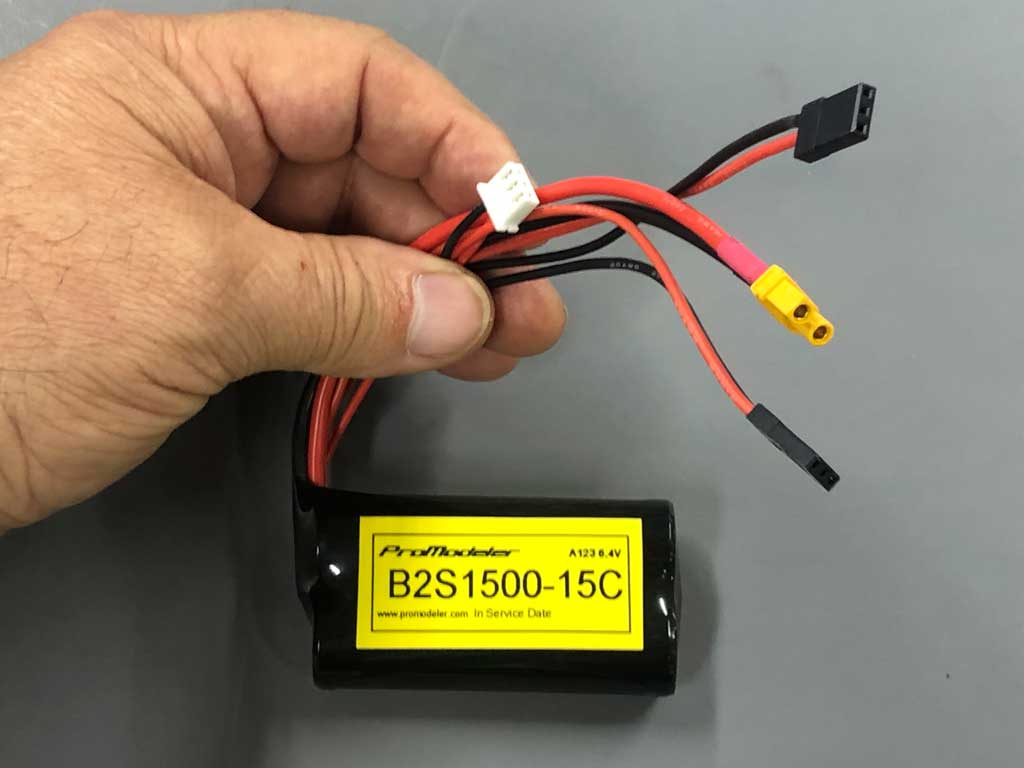

Anyway, this battery gives you 22.5A (1.5Ah x 15C = 22.5A), which is still more than you can use! As an engineer, I like a bit of safety margin. It makes me feel good. And any 2S lithium-based pack on this Earth (no matter how cheap it is to buy) delivers a healthy current-margin over a BEC . . . by a mile! Moreover, I have ours built with two leads instead of one because each delivers 3.5A and thus, using two in parallel means the pack can deliver 7A.
Note 4: 7A isn't a limit like hitting a block wall because the servos may well draw more current at the expense of heat at the connector, so if they momentarily draw 15A, but they only do so for a second or two, then it won't matter because it's not enough time for enough heat to accumulate, e.g. it won't amount to a rat's ass of worry in my mind.
So remember, there's no BEC mere mortals can buy that'll deliver the kinds of current you may need when powering all 11 servos, plus the retracts, and the lighting without compromises like unbalanced loads. Thus, you're better off using 'any' lithium-based battery pack for the flight control avionics, instead because a 2S LiPo pack will deliver the goods whilst actually loafing instead of working hard. Yes, any 2S pack does this easily, but please shop for one with two leads because this is important in terms of delivering 7A through two connectors versus 3.5A with just the one.
Added to which, while I can't speak for you, I like cheap and easy. The two words even sound nice together, agreed? Along with the 2S pack you'll continue running a BEC, but my advice is use the CC BEC 2.0 instead of the OEM unit, but operating it off 12S (both packs). This, for two reasons. First, because then the loads are shared between both propulsion packs. And second, because while it's only outputting 7A, since you've removed the servo loads for the flight controls, then it's leaving a lot more overhead for powering the blue box and the ancillary stuff, capice?
Anyway, splitting the voltage sources and retrofitting better servos will give you a better experience with the Mig-29 because then it will have the oomph (there's that technical word again) to either finesse or horse your model through the various maneuvers. Added to which, LiPos represent a cheap and easy solution. Yes, the servos and updating the BEC are gonna cost - but c'mon - what's a model going splat gonna cost you? To say nothing of the risk if it dives into the pits and hurts someone!
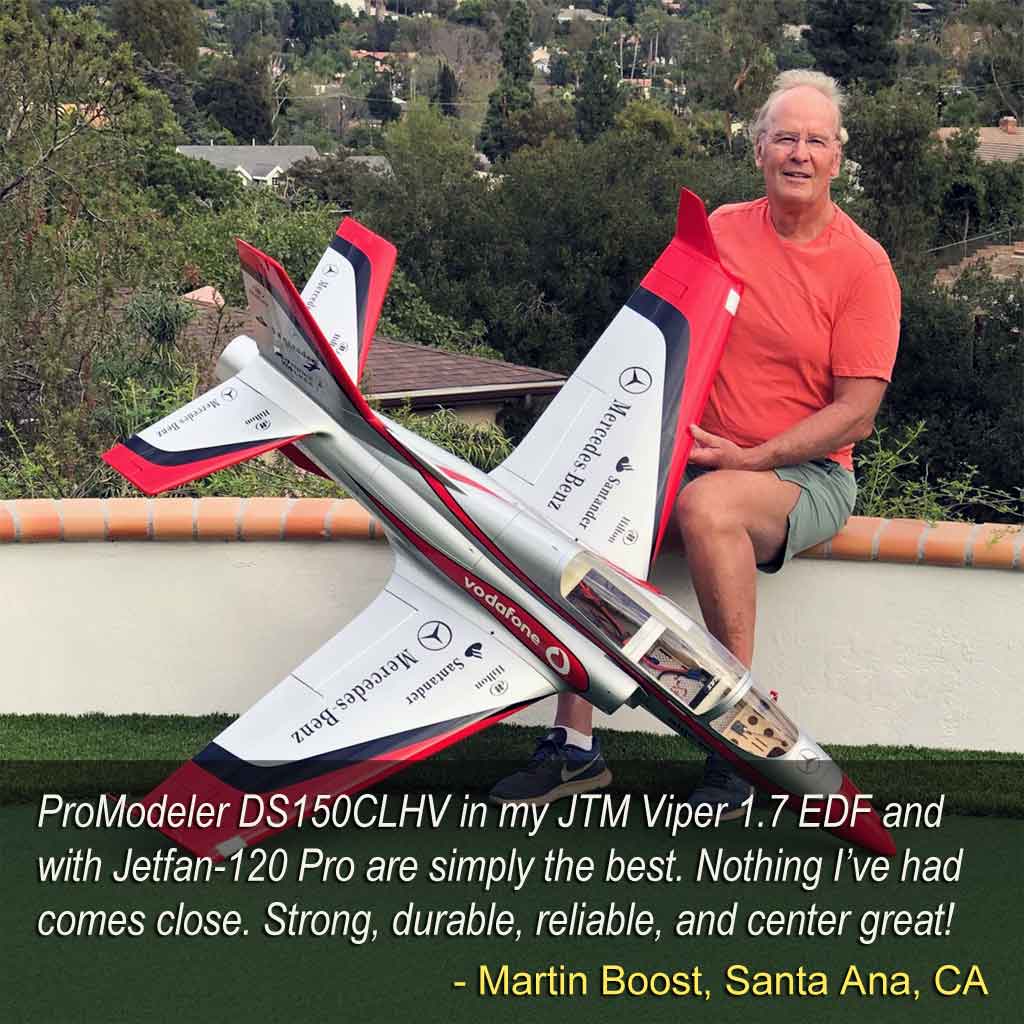

Solutions continued:
3. The extensions supplied are worth a look in my opinion, especially when the model is equipped with more powerful servos. Pain in the ass to swap them out if needs be? Yup! Put on your big boy pants and accept the fact it may need to be done, sorry. Anyway, going to 20AWG where possible minimizes the possibility of voltage loss at the servos, and does so at a trivial increase in weight. I'll link to an another article I wrote, which explains how to calculate the voltage loss based on wire gauge, below.
4. Control push rods are reported as 0.0625" diameter. I'm not certain regarding their dimension but sleeving them with a pultruded carbon fiber tube is easy and inexpensive. Also, it's important to epoxy the tubes into place on the wire (I like JB Weld for this job) because it's how you create a strong bond. And take special note of what that modeler did in the pushrod photo of using brass tubing over the carbon tube because this restrains it from splitting - smart dude, eh? Anyway, this is what modeling's about folks!

Summary:
This isn't rocket science. For electronics to function reliably they need a good source of juice, defined by me as . . . sufficient voltage and current at the servo to do the job. A 2S LiPo will supply it in spades for the mission critical control avionics, and the OEM BEC will continue to do the lower risk things like retracting and extending the undercarriage, operating the wheel-bay doors, and making the lights look pretty. But if it were my model, then because I'm an in for a penny, in for a pound kind of guy, then the OEM BEC would be replaced with a CC BEC Pro for the blue box stuff in parallel with a 2S LiPo battery for the flight controls . . . but that's just me. This decision is on you!
Recapping further; better servos in light of what's at risk when you throttle up are a no-brainer. Improving the control push rods is easy and and possibly replacing servo-extensions for ones more capable of handling higher current draw and thus ensuring higher voltage at the servo, is just smart modeling.
As we've discussed, a LiPo is better than any BEC on the planet. This, more than because it offers up more current but because the juice is perfectly clean. BECs synthetically create the desired voltage by averaging a high and a low wave. It's noisy and dirty in comparison to the smooth voltage delivered by a real DC-source. Me? While our servos will run fine on the comparatively dirty BEC-power, I'd rather not subject my delicate control-electronics (receivers and gyros) to that junk. If you know better than me, do your thing because it's no skin off my nose since it's your model. So pick your poison and don't complain later!

Closing thoughts:
The servos I've recommend are used in scale jets by top modelers. For example, Bret Becker is 'the one' this year. The One means he's the guy who took all the marbles and won Expert Class at Top Gun. He did it with 120mm Schubeler HDS86 fan unit on 12S thrusting his U-2 model, which goes 23 pounds and spans 120" using . . . an DS105CLHV for rudder, DS150CLHV for ailerons and tail wheel, plus our remarkable super minis, the DS355CLHB (yes, 355oz-in mini-size) on elevators and flaps, both.
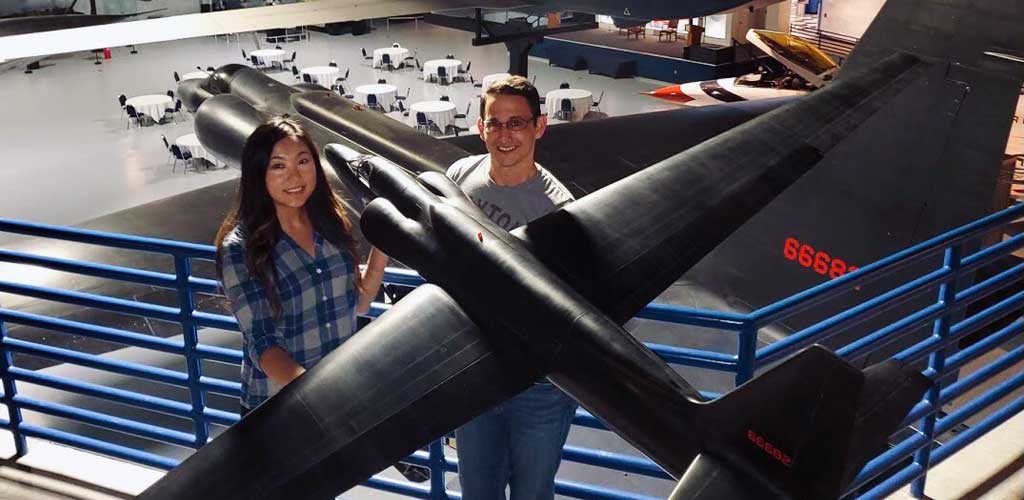
- Bret and his lovely wife Wency and his Top Gun Expert Class winning U-2

His U-2 is definitely not an ARF, which you can assemble and fly in a few days. Instead, it represents the culmination of the modeler's art. His model is an endeavor most folks can only look at in awe, and stare at in wonder. The point being, maybe you should look into ProModeler servos for your pride and joy, too (end of self-serving propaganda - I couldn't help myself because I love scale models more than anything).
And to be fair, if you favor something else, perhaps an HV69 or D85MG (both decent servos produced by good competitors), e.g. if you think they're better for you, then go ahead because you won't hurt my feelings!
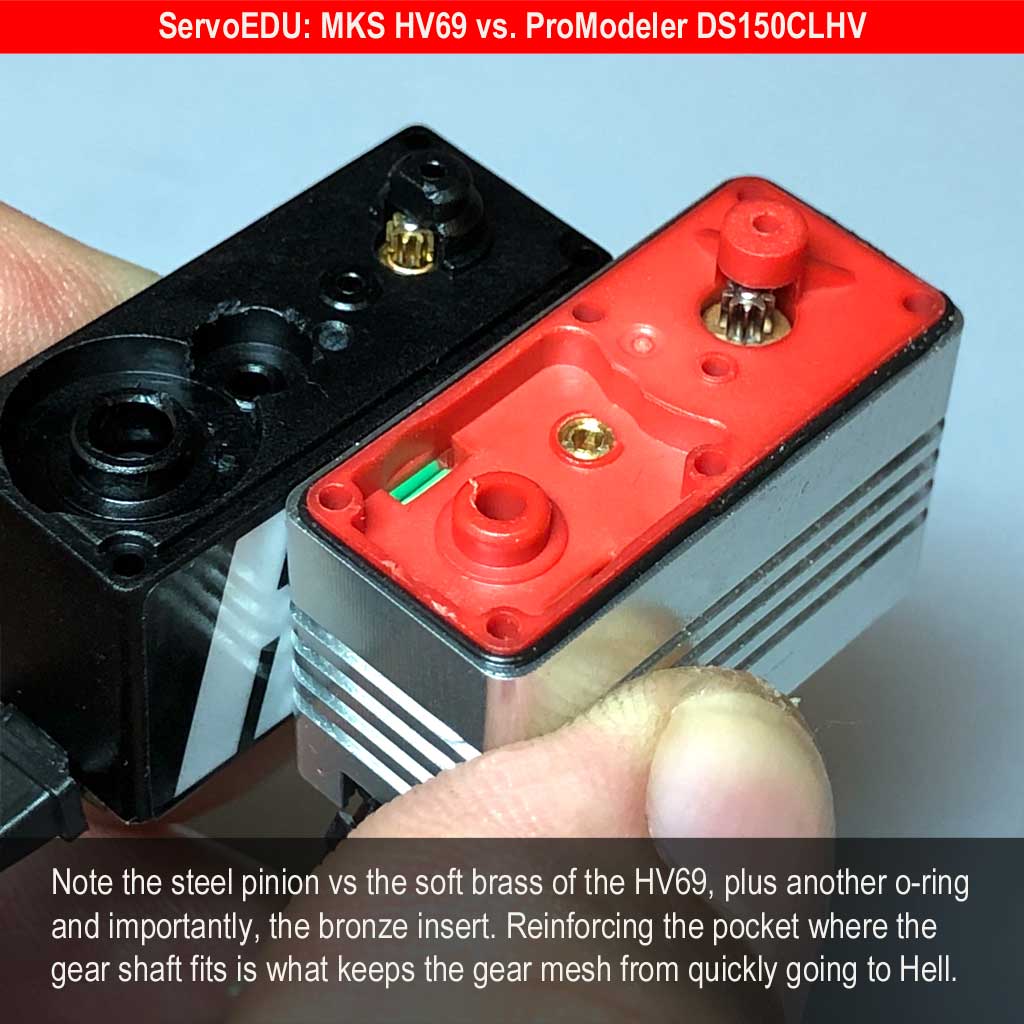

Wrapping things up; if you've read this far, then you're now probably better equipped to decide on how best to make your Freewing Mig-29 better and safer - both. Sure, I hope you do it with our servos - but - I won't lose any sleep if you opt for a competitor's because safety is more important than anything!

Resources: